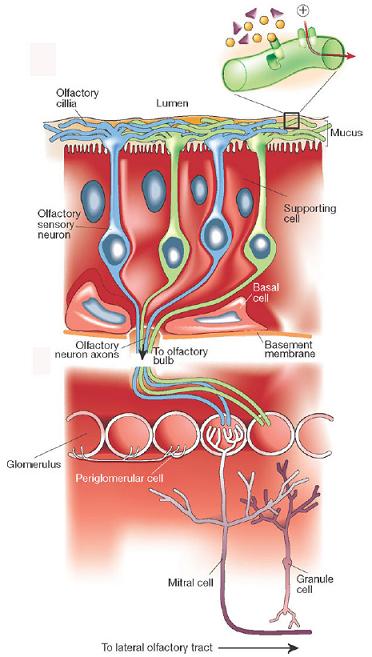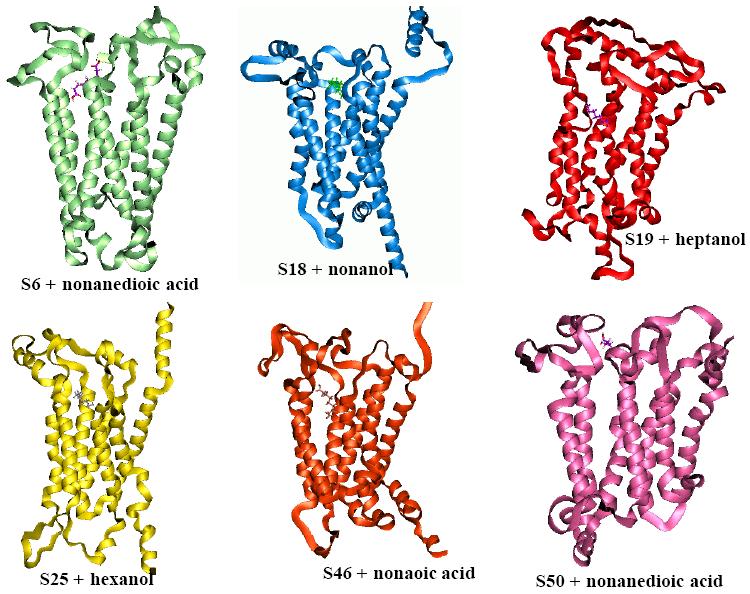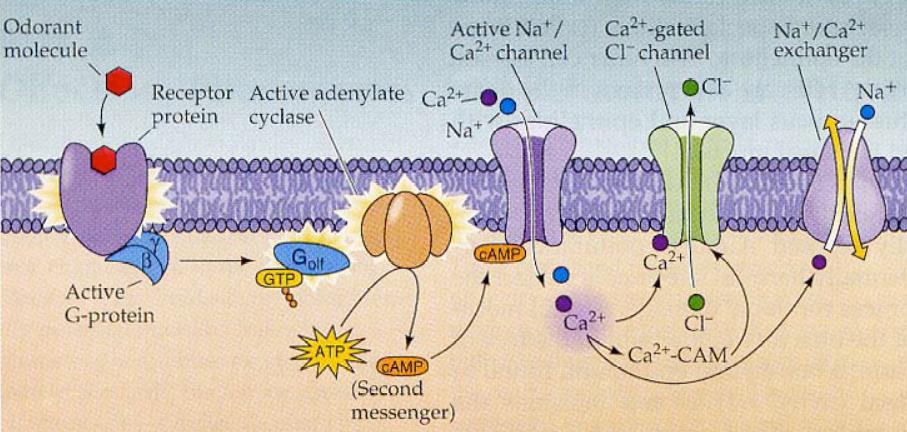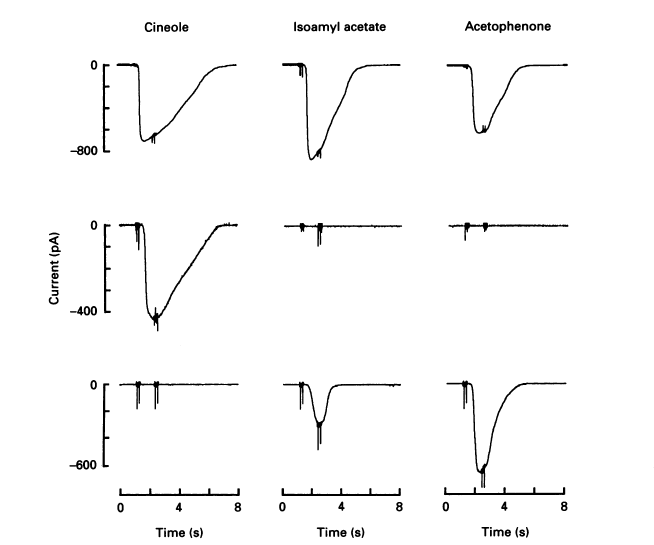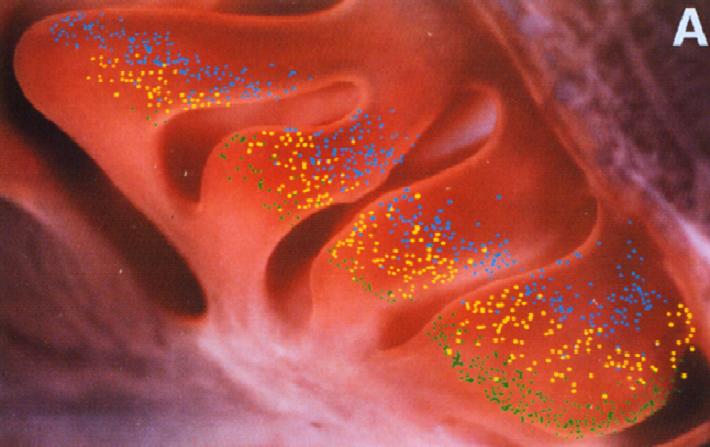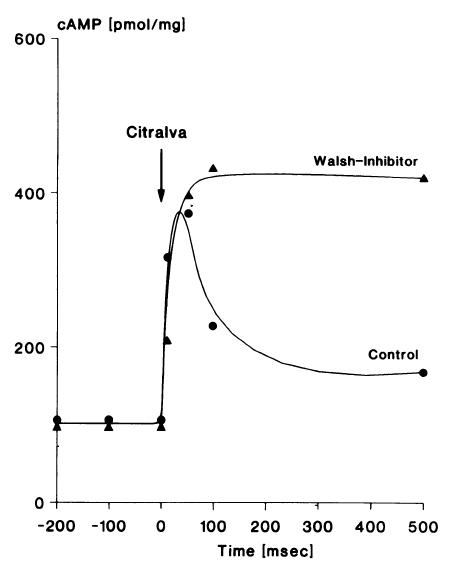BIO254:ORs
What is an Olfactory Receptor?
An olfactory receptor is a G-protein coupled receptor to detect odorant in order to generate the sense of smell. These receptors are in olfactory sensory neurons, which are in the dorsal-posterior nasal cavity epithelium. To distinguish different odorants, each olfactory sensory neuron expresses only one type of odorant receptors. Activation of an odorant receptor evokes action potentials in the olfactory sensory neurons, which relay information to the olfactory bulb in the brain.
See figure below for the organization of olfactory system.
Olfactory Receptor Structure
Olfacory receptors are seven helix transmembrane proteins belonging to the G protein coupled receptors family. Variation in the amino acid sequences of the transmembrane domains may account for the recognition of different, diverse odorants. Below are atomic-level models for mouse olfactory receptors S6, S18, S19, S25, S46 and S50 showing the binding sites for odor recognition.(adapted from ref 5.)
Olfactory Receptor Activation
When an odorant binds to an olfactory receptor, it activates the G-protein cascade leading to activation of adenylyl cyclase by the GTP-coupled alpha subunit. Activation of adenylyl cyclase increases production of cAMP, which acts as a second messenger that opens a Cyclic nucleotide-gated ion channel (CNG). The opened CNG brings influx of Ca++. The influx of Ca++ not only slightly depolarises the cell, but also opens a Ca++ activated chloride channel leading to efflux of Cl- and thus further depolarises. The overall result is the triggering of an action potential.
The following picture is adapted from Lecture 11 of the class, as a shematic of the signaling pathway.
Olfactory Receptor Function
Activation of an odorant receptor results in the production of action potentials that relay information to the olfactory bulb in the brain.
Current responses to the indicated odorants at 5 x 1O^-4 M applied for 1P2 s in three different cells responding to all three odorants (upper row), cineole only (middle row), acetophenone and isoamyl acetate (bottom row). An electrical artifact, caused by the stepping motor and indicative of the onset and offset of the stimulus, was present in each trace.(Firestein, 1993).
Olfactory Receptors Organization
By examining the spatial distribution of odorant receptor RNAs in the mouse olfactory epithelium, it is discovered there are topographically distinct patterns on the nasal cavity. This indicates that the nasal cavity is divided into series of zones. This patterning may serve as an initial organizing step in olfactory sensory information coding.
The following figure is adapted from ref 6. It is a schematic representation of turbinates illustrating three distinct zones in which the following odorant receptors or receptor subfamilies are expressed: green, F12, F23, I7 I8, and J2; yellow, F3 and F5; blue, F6, J7, and J14.
Groups of olfactory sensory neurons that express the same receptor are located in the same area of the dorsal-posterior nasal epithelium (in humans). The axons from these neurons project to specific groups of glomeruli in the olfactory bulb. Therefore, the olfactory bulb is topographically organized.
There are up to 1000 different types of odorant receptor genes in rodents, and 500-750 in humans, of which 100-200 produce functional products. Although humans have a fewer number of functional receptors than other animals, the odorant receptor family is very diverse, and allows us to discriminate between approximately 10,000 odorants of different shapes and sizes. Although all odorant receptors share the same basic structure and have several conserved sequences, each one is a unique entity. Much of the diversity in odorant receptors is due to diversity in the amino acid sequence of their transmembrane domains.
Olfactory Receptors Desensitization and Adaptation
Both adaptation and desensitization can occur after continuous or repeated exposure to a particular odorant. Adaptation is defined as the inability to smell an odorant following continuous exposure. Adaptation can occur via two mechanisms:
1) Desensitization: involves the phosphorylation and subsequent inactivation of odorant receptors following continuous exposure. These processes mainly disrupt the key elements in the signaling pathway of the olfactory system. For example, by using isolated rat olfactory cilia, it has been demonstrated that odorant-induced second messenger singaling in the millisecond time range is terminated via phosphorylation reactions catalyzed by specific protein kinases. See figure below(adapted from ref 7.):
A key feature of response in the olfactory system is the transient nature: a rapid and transient response to a short stimulus is essential and typical for olfactory receptor cell. The concentration of cAMP signal in the control nicely shows this feature after the stimulation of Citralva. However, when added Walsh inhibitor, a specific inhibitor for kinase A, the induced cAMP level persisted over a long time, and saturate the system.
2) Another mechanism underlying odorant adaptation is a modulation of the cAMP-gated channel by Ca++ feedback. It has been shown that Ca++ reduces the apparent affinity of the cAMP-gated channel by up to 20-fold in the presence of calmodulin, which is abundant in olfactory cilia.
References
1) Firestein, Stuart. 2003. Electrical signals in olfactory transduction. Current Opinion in Neurobiology. 2:444-448.
2) Firestein, S., Picco, C., Menini, A. 1993. The relation between stimulus and response in olfactory receptor cells of the tiger slalmander. J. Physiol. 468:1-10.
3) Kandel, E.R., Schwartz, J.H., Jessell, T.M. 2000. Principles of Neural Science: chapter 32. 4th Edition
4) Purvves et. al. 2001. Neuroscience: chapter 15. 2nd Edition.
5) Vaidehi et al. 2002. Predition of structure and funtion of G protein-coupled receptors. Proc Natl Acad Sci U S A. 2002 October 1; 99(20): 12622–12627
6) Vassar et al. 1993. Spatial segregation of OR expression in the mammalian olfactory epithelium. Cell 74: 309-18.
7) Boekhoff, I., & Breer, H. (1992). Termination of 2nd-messenger signalling in olfaction, Proc. Nat. Acad. Sci. USA. 89, 471-474.
Recent updates to the site:
List of abbreviations:
- N
- This edit created a new page (also see list of new pages)
- m
- This is a minor edit
- b
- This edit was performed by a bot
- (±123)
- The page size changed by this number of bytes
15 December 2025
| 22:33 | Hu:Publications diffhist +21 Hugangqing talk contribs | ||||
14 December 2025
|
|
15:04 | Hu:Publications 2 changes history +265 [Hugangqing (2×)] | |||
|
|
15:04 (cur | prev) −1 Hugangqing talk contribs | ||||
|
|
15:04 (cur | prev) +266 Hugangqing talk contribs | ||||
| 14:59 | Hu diffhist +99 Hugangqing talk contribs | ||||

